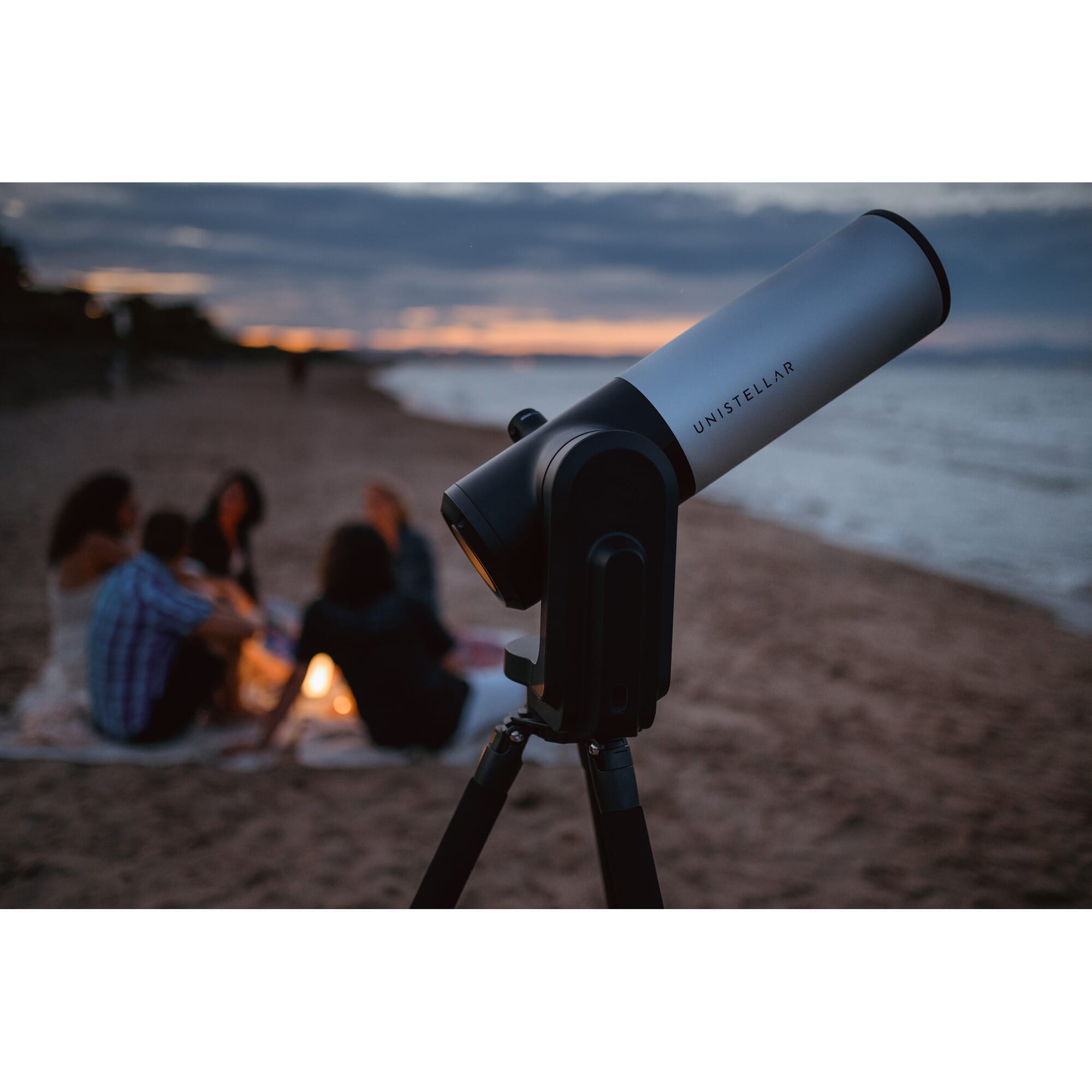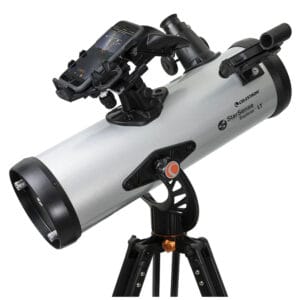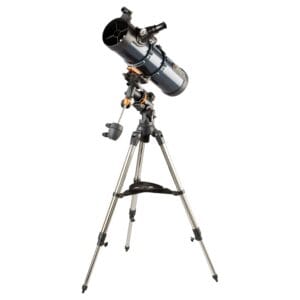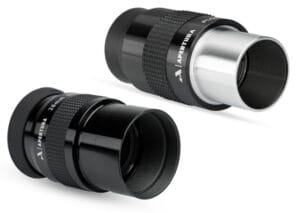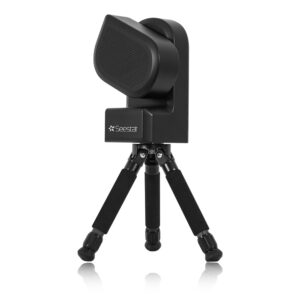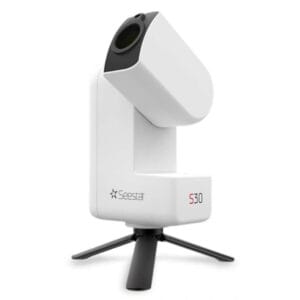Due to increasing popularity, we often get asked “what is a smart telescope”? A smart telescope is a fully automated telescope that automatically recognizes, tracks, and photographs objects in the night sky. Instead of manual aiming or using complex settings, you let the smart telescope do everything for you via an app on your smartphone or tablet.
How Does a Smart Telescope Work?
Smart telescopes combine optics with smart software. They are equipped with:
- a camera instead of an eyepiece,
- a computer module with image recognition and celestial object database,
- and a motorized mount that automatically tracks objects.
After startup, the telescope scans the night sky, determines its orientation, and calibrates itself. Via an app, you can select, for example, “Andromeda Galaxy” or “Saturn”, and the telescope automatically moves to the correct celestial object. You see the result live on your screen, including stacking (layering photos to create sharper images), filters, and photo storage.
What’s the Difference from a Regular Telescope?
A classic telescope requires knowledge of star charts, object coordinates, and often technical skill. You manually search for objects, need to focus through an eyepiece, and possibly take photos yourself with a DSLR or CMOS camera. A smart telescope automates this entire process.
| Feature | Smart telescope | Classic telescope |
|---|---|---|
| Finding objects | Automatically via app | Manually or via GoTo system |
| Image display | On smartphone or tablet (digital) | Through eyepiece (optical) |
| Photography | Built-in, automatically stacked | Requires separate camera + settings |
| Learning curve | Very low/moderate (post-processing makes it moderate to high) | Moderate to high |
| Suitable for | Everyone | Everyone, depending on model |
Who is a Smart Telescope Suitable for?
Smart telescopes are designed for two target groups:
- Beginners who want quick results without much setup. They want to see the moon, planets, and nebulae without technical barriers.
- Astrophotographers who appreciate automatic stacking, filters, and app control, for example during vacations or quick sessions.
They are less suitable for those who want to observe visually through an eyepiece, but they can provide an excellent stepping stone to exploring and learning about our night sky.
What Smart Telescopes are Available?
The smart telescope market is rapidly evolving. While there was hardly any choice a few years ago, there are now multiple models that truly impress, and more are coming. Here’s an overview of the most well-known types and what distinguishes them:
- Seestar S30
A light, compact entry-level model at a competitive price. Ideal for those wanting to explore smart telescopes without spending €700 right away. Works quickly and simply, with surprisingly good images of the moon, star clusters, and bright nebulae. Less sharp than the S50, but perfect for a first experience. - Seestar S50
The bigger brother of the S30. With better optics, a longer focal length, and robust all-in-one construction. This model is popular among beginners who want to get more out of their observing sessions without complex settings. Excellent value for money. - DWARF 3
More freedom, more control. The DWARF 3 has a more advanced sensor (IMX678), manual settings for exposure and stacking, and a wider field of view. Ideal for those who want to go beyond “point and shoot”, and want to experiment with astrophotography settings. - Vespera II and Vespera Pro (Vaonis)
Luxury models with beautiful design and high image quality. The Vespera series combines technology with aesthetics and offers beautiful photos of deep-sky objects. The Pro variant has a larger sensor and more resolution but comes with a hefty price tag. For those who want to combine design, performance, and ease of use. - Unistellar eVscope 2
Unique in this lineup because you can also look visually through an eyepiece, thanks to their patented “enhanced vision” technology. It feels like looking through a classic telescope, but enhanced via digital stacking. Innovative but expensive. A niche choice for those who value that visual experience. - GoTo models with smart support
Think of the Celestron StarSense Explorer or automated GoTo mounts with app integration. These models combine the classic telescope form with digital search assistance. They’re not “smart telescopes” in the strict sense, but they are smart in use and ideal for those who still want to look for themselves but don’t want to search manually.
Developments are moving quickly: manufacturers like ZWO, Vaonis, and Unistellar continue to improve their systems, and brands like Sky-Watcher and Celestron are heavily investing in hybrid models. In the coming years, you can expect many new features, from faster image processing to all-in-one systems with integrated AI. Those starting now are riding an exciting technological wave in the world of stargazing.
What are the Advantages of a Smart Telescope?
- You can see objects that are normally barely visible (like nebulae) thanks to stacking
- You can take photos immediately without astrophotography experience
- No need for alignment or calibration
- Perfect for children, families, and beginning enthusiasts
A smart telescope significantly lowers the entry barrier. Where classic setups often lead to frustration for beginners, a smart model delivers results within minutes.
Are there any Disadvantages?
Yes, and these should be honestly mentioned:
- You don’t look through an eyepiece: the image is digital
- You need a smartphone or tablet
- The models are not (yet) all suitable for planets: mainly deep-sky and the moon/sun
- Planetary details are limited compared to large classic telescopes
However, for those seeking convenience and photography, these limitations are often acceptable.
Conclusion: What is a Smart Telescope?
A smart telescope is the fastest and simplest way to explore the universe. You don’t need to be an expert to capture spectacular images of galaxies, nebulae, or the moon. Whether you’re looking for your first experience or want an efficient addition to your existing equipment, a smart telescope is THE tool for modern stargazers.
Want to know if a smart telescope is right for you? Visit telescoop.nl and discover the differences between the Seestar, DWARF, and Vespera models, with customized advice for your situation.

